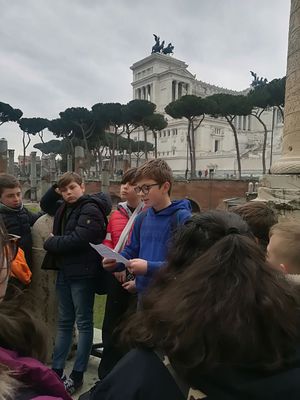Here the students and teachers of Montezemolo will upload all the materials produced during the project












L'ARA DI CESARE
Il tempio del Divo Giulio (aedes Divi Iulii) è un tempio dedicato a Gaio Giulio Cesare, divinizzato dopo la sua morte, situato a Roma nel Foro romano. Cesare fu il primo romano ad essere divinizzato dopo la sua morte, e di conseguenza onorato con un tempio, dopo il mitico fondatore Romolo. Il tempio fu eretto da Augusto il 18 agosto del 29 a.C.
Cesare venne ucciso in una seduta del Senato tenutasi nella Curia Pompeia nel Campo Marzio. Il suo corpo venne poi trasportato nel Foro, vicino alla Regia, che era la sede ufficiale del pontefice massimo, carica rivestita dal dittatore. In questo luogo, all'estremità orientale della piazza del Foro, venne accesa la pira funebre improvvisata per la cremazione e si svolsero i suoi funerali. Qui venne eretto un altare [2], affiancato da una colonna in marmo giallo antico con l'iscrizione Parenti Patriae ("al padre della patria").
I saccheggi particolarmente distruttivi avvenuti nei secoli e particolarmente nel XV , distrussero il tempio e solo con gli scavi condotti tra il 1872 e il 1950 riuscirono a portare alla luce i resti dell'edificio.
Oggi sono visibili i resti del podio del tempio, in cementizio, in origine rivestito esternamente da un paramento in opera quadrata di blocchi di tufo, a sua volta ricoperto da lastre di marmo. I vuoti attualmente presenti tra i nuclei di cementizio sono dovuti all'asportazione per un successivo riutilizzo dei blocchi di travertino nel XV secolo, i quali costituivano le fondazioni del colonnato della fronte e del muro anteriore della cella, permettendo di riconoscerne con precisione la posizione. Sul lato anteriore del podio, che conserva in alcuni punti il coronamento e lo zoccolo in marmo lunense, è presente un'esedra semicircolare, rivestita in blocchi di tufo dell'Aniene e di peperino, entro la quale si trova un piccolo elemento circolare in cementizio, identificabile come un altare: si tratta probabilmente del rifacimento da parte di Ottaviano, forse negli anni 37-34 a.C., dell'altare eretto dopo la morte di Cesare nel 44 a.C. e subito eliminato. Al momento della costruzione del tempio l'altare venne rispettato con l'apertura dell'esedra (spazio semicircolare scoperto) sulla fronte del podio.
THE ARA OF CESARE
The temple of the Divo Giulio (aedes Divi Iulii) is a temple dedicated to Gaius Julius Caesar, deified after his death, located in Rome in the Roman Forum. Caesar was the first Roman to be deified after his death, and consequently honored with a temple, after the mythical founder Romulus. The temple was erected by Augustus on August 18 of 29 B.C.
Caesar was killed in a session of the Senate held in the Curia Pompeia in Campo Marzio. His body was then transported to the Forum, close to the Regia, which was the official seat of the maximum pontiff, a charge covered by the dictator. In this place, at the eastern end of the Piazza del Foro, the funeral pyre was lit for the cremation and his funeral took place. Here an altar was erected [2], flanked by an ancient yellow marble column with the inscription Parenti Patriae ("to the father of the fatherland").
The particularly destructive looting occurred in the centuries and particularly in the XV, destroyed the temple and only with the excavations conducted between 1872 and 1950 they managed to unearth the remains of the building. Today it is possible to see the remains of the temple podium, in cement, originally covered externally by a square face of blocks of tuff, in turn covered with marble slabs. The voids currently present between the cement cores are due to the removal for a subsequent reuse of the travertine blocks in the fifteenth century, which constituted the foundations of the colonnade of the front and the front wall of the cell, allowing to accurately recognize the position. On the front side of the podium, which retains in some points the crown and the base in Lunense marble, there is a semicircular exedra, covered in blocks of Aniene and peperino tuff, within which there is a small circular element in cement , identifiable as an altar: it is probably the reconstruction by Octavian, perhaps in the years 37-34 BC, of the altar erected after the death of Caesar in 44 BC and immediately eliminated. At the time of construction of the temple the altar was respected with the opening of the exedra (uncovered semicircular space) on the front of the podium.